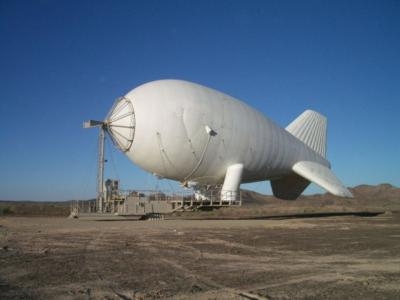Airship Provides Visual And Audio Battlefield Surveillance
The Persistent Threat Detection System entered its next chapter, May 29, as Lt. Col. Michael Parodi, product manager Meteorological and Target Identification, was on hand at the Lockheed Martin facility in Dayton, Ohio; to accept the delivery of the last PTDS ordered. Since its original introduction as a quick reaction capability the Army has procured 66 systems that have been used in both Iraq and Afghanistan.

Persistent Threat Detection System, or PTDS, is a large aerostat tethered to a mooring platform, which is accompanied by a Ground Control Station, or GCS. The system is equipped with both visual and audio surveillance technology. Since the Civil War, when Union Soldiers utilized hot air balloons to serve as a surveillance platform, lighter than air technology has been a part of the Army's inventory. As U.S. forces began a troop surge in Afghanistan while maintaining security in Iraq the need to provide soldiers with a persistent view of the battlefield was paramount.
In 2008, then-Secretary of Defense Robert Gates directed an Intelligence, Surveillance and Reconnaissance, or ISR, surge dedicated to providing Soldiers with the ability to understand their environment. One of the systems that was fielded to support the ISR surge was PTDS. "PTDS has proven to be a great asset for Soldiers, Sailors, Airmen, Marines as well as our coalition partners serving in harm's way." said Parodi. "They have been instrumental in providing mission overwatch, detecting [improvised explosive devices] and assisting in the capture of numerous high value targets and weapons caches."
PTDS acts as a force multiplier for commanders on the ground as it can be utilized to scan large areas of terrain for potential insurgent activity while interacting with various other sensors to give a complete picture of potential threats. Information collected by the system is distributed to soldiers via various routes including the Distributed Common Ground System-Army, or DCGS-A; which is an intelligence tool. Convoy protection, counter-improvised explosive device and a real-time perspective of engagements with the enemy are amongst the roles PTDS play for troops on the ground. "Our commanders in the field have incorporated PTDS into many of their missions including force protection; while local citizens recognize the platform provides an unblinking eye keeping watch for insurgent activity," noted Parodi.
The system operates 24 hours a day utilizing a crew of five operators working 12 hours shifts. With an ability to reach heights that are out of the range of most enemy threats, PTDS offers the user a vast perspective of the battlefield. Since its original fielding the system has seen numerous improvements including the addition of a second sensor to provide greater ISR coverage as well as improvements to the aerostat itself, better weather effects survivability and weather forecasting, increased lift and payload capability, and improved network and equipment connectivity.
(U.S. Army photo)
 Sierra Space Repositions Dream Chaser for First Mission
Sierra Space Repositions Dream Chaser for First Mission ANN's Daily Aero-Term (05.10.24): Takeoff Roll
ANN's Daily Aero-Term (05.10.24): Takeoff Roll Aero-News: Quote of the Day (05.10.24)
Aero-News: Quote of the Day (05.10.24) Aero-News: Quote of the Day (05.11.24)
Aero-News: Quote of the Day (05.11.24) ANN's Daily Aero-Term (05.11.24): IDENT Feature
ANN's Daily Aero-Term (05.11.24): IDENT Feature



